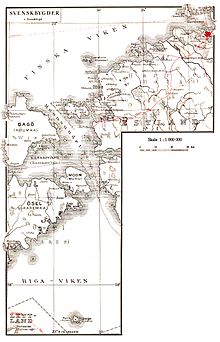Estonian Swedish
| Estonian Swedish | |
|---|---|
| estlandssvenska | |
 Estonian Swedes on Ruhnu, 1937 | |
| Region | Estonia, Ukraine |
Indo-European
| |
| Language codes | |
| ISO 639-3 | – |
| Glottolog | esto1259 |
| IETF | sv-EE |
| Part of a series on the |
| Swedish language |
|---|
| Topics |
| Advanced topics |
| Variants |
| Dialects |
|
| Teaching |
|
Higher category: Language |
Estonian Swedish (Swedish: estlandssvenska; Estonian: rannarootsi keel, lit. 'Coastal Swedish') are the eastern varieties of the Swedish language that were spoken in the formerly Swedish-populated areas of Estonia (locally known as Aiboland) on the islands of Ormsö (Vormsi), Ösel (Saaremaa), Dagö (Hiiumaa) and Runö (Ruhnu), and the peninsula (former island) of Nuckö (Noarootsi), by the local Estonian Swedes.[2]
Until the evacuation of the Estonian Swedes near the end of World War II, both Swedish and Estonian were commonly spoken on the named islands. It is not clear if there are any native speakers left.[3] After Estonia's independence following the dissolution of the Soviet Union, Estonian Swedish experienced a revival, with courses in the language being offered on Dagö and Ösel.

Currently, the number of native speakers is unknown, but assumed to be low.[1]
Usage
[edit]The Gammalsvenska dialect of Swedish spoken in Ukraine is an archaic dialect of Estonian Swedish, having been brought to the village of Gammalsvenskby in the late 1700s by settlers from Dagö.[4]
Writing system
[edit]Noarootsi Swedish is written with the same letters as Standard Swedish with a few phonetic additions:[5]
- Long vowels are indicated with a subscribed macron: ⟨a̱, ä̱, å̱, e̱, i̱, o̱, u̱⟩.
- Long consonants are doubled : ⟨bb, dd, ...⟩.
- The /d/ and /n/ rhotics are denoted with a dot below ⟨ḍ, ṇ⟩.
- The voiced retroflex flap /ɽ/, called "thick L", is noted with a dot below ⟨ḷ⟩.
- The voiceless postalveolar fricative consonant /ʃ/ is noted with a dot below ⟨ṣ⟩.
See also
[edit]References
[edit]- ^ a b Rosenkvist, Henrik (2018). "Estlandssvenskans språkstruktur" [The linguistic structure of Estonian Swedish] (PDF) (in Swedish). University of Gothenburg. Archived (PDF) from the original on 1 August 2020. Retrieved 18 June 2020.
- ^ "Svenska ortnamn i Estland" [Swedish place names in Estonia]. sprakinstitutet.fi (in Swedish). Institute for the Languages of Finland. Archived from the original on 9 April 2022. Retrieved 15 November 2019.
- ^ Hammarström, Harald; Forke, Robert; Haspelmath, Martin; Bank, Sebastian, eds. (2020). "Estonian Swedish". Glottolog 4.3. Archived from the original on 9 April 2022. Retrieved 2 December 2020.
- ^ "Gammölsvänsk". The Language Archive. Nijmegen, Netherlands: Max Planck Institute for Psycholinguistics. hdl:1839/00-0000-0000-0008-A981-0. Archived from the original on 3 August 2021. Retrieved 2 March 2021.
- ^ Brunberg 2010
Further reading
[edit]- Axel Olof Freudenthal; Herman Vendell (1887), Ordbok öfver estländsk-svenska dialekterna, Skrifter utgivna av Svenska litteratursällskapet i Finland (in Swedish), Helsinki: Society of Swedish Literature in Finland, ISSN 0039-6842, Wikidata Q112264898
